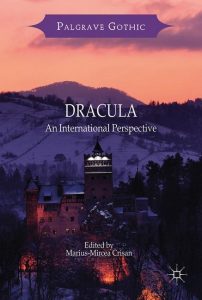Since Dracula is in the news just now following my stint on the BBC World Service I thought I would mention an essay I wrote on the novel which grew out of OGOM’s collaboration with scholars at the University of Timisoara in Romania. Kaja and I have both visited and contributed to symposia there. My essay is inspired by my visits to Romania and the novel’s troubled history in that country. After my first visit I was invited back to deliver a plenary at the ‘Beliefs and Behaviours in Education and Culture’ conference I blogged on my return about Bram Stoker’s ambiguous legacy and the fact that generations of Romanians were not allowed access to the novel. Ceauceascu banned the novel and film of Dracula so those coming of age in Romania in the 1980s would not be familiar with the country’s most infamous resident.
Out of these debates has grown Dracula : An International Perspective, ed. by Marius-Mircea Crisan in the Palgrave Gothic Series. The book draws on literature, tourism, and film and argues that the development of the Dracula myth is the result of complex international influences and cultural interactions. My essay is entitled ‘Spirited Away: Dream Work, the Outsider and the Representation of Transylvania in the Pied Piper and Dracula Myth in Britain and Germany’.The book which also boasts essays by William Hughes, Clive Bloom, Carol Senf, Duncan Light, John Edgar Browning and others is out in December 1st st. You can order copies here!

Full Contents List:
- “Welcome to my house! Enter freely and of your own free will”: Dracula in international contexts – Marius-Mircea Crisan.-
- The Casework Relationship: Le Fanu, Stoker and the Rhetorical Contexts of Irish Gothic – William Hughes.
- The Discourse of Italy in Nineteenth Century Irish Gothic: Maturin’s Fatal Revenge, Le Fanu’s exotic tales, and The Castle of Savina – Donatella Abbate Badin.
- “Bloodthirsty and Remorseless Fangs”: Representation of East-Central Europe in Edgar Allan Poe’s Gothic short stories – Lucian-Vasile Szabo, Marius-Mircea Crisan.
- Spirited Away: Dream Work, the Outsider, and the Representation of Transylvania in the Pied Piper and Dracula Myth in Britain and Germany – Sam George.
- Count Dracula’s Lifetime Identity and Address – Hans Corneel de Roos
- Dracula and the Psychic World of the East End of London – Clive Bloom.
- Tourism and Travel in Bram Stoker’s Dracula – Duncan Light.
- Castle Hunedoara and the Dracula Myth: Connection or Speculation? – Marius-Mircea Crisan.
- Location and the Vampire: The Impact of Fictional Stories upon Associated Locations – Kristin L. Bone.
- In Search of Dracula’s Oracular History – John Edgar Browning.-
- Vampiric Emotion and Identity in Dracula and Interview with the Vampire – Nancy Schumann.
- Gothic and Horror in Contemporary Cinema and Television: Aesthetic Experience and Emotional Impact – Magdalena Grabias
- Papa Dracula: Vampires for Family Values? – Dorota Babilas.
- The Evolution of Gothic Spaces: Ruins, Forests, Urban Jungles – Carol Senf.

Pingback: O apariție de excepție: Dracula în perspectivă internațională - Revista Helion Online